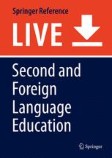Search
Search Results
-
Pictorial representations of simple arithmetic problems are not always helpful: a cognitive load perspective
At the start of mathematics education children are often presented with addition and subtraction problems in the form of pictures. They are asked to...

-
The Methods Issue Revisited: From a Developmental and a Socio-Cultural-Political Perspective
This chapter aims at discussing several aspects of the “methods issue” rather than at offering a systematic review of the specialized literature. It...
-
Combining Physical, Virtual, and Mental Actions and Objects
The grounding of cognition in embodied actions has resulted in both theoretical formulations of encoding of information and instructional...

-
Medium-of-Instruction Debate II: Teaching Chinese in Putonghua (TCP)?
In this chapter, we will first contextualize the debate surrounding the teaching of Putonghua in Hong Kong by reviewing the relevant literature in...
-
Bilingualism and Second Language Acquisition
Language researchers have traditionally drawn distinctions between phenomena of “bilingualism” and the processes and features of “second language...
-
Nihon**ron, Native-Speakerism, and Recent MEXT Policies on EFL Education
My overarching goals in this book are to observe how EFL education is conducted at four Japanese JHS, explore how ICC-oriented content and education...
-
There’s more to the multimedia effect than meets the eye: is seeing pictures believing?
Textbooks in applied mathematics often use graphs to explain the meaning of formulae, even though their benefit is still not fully explored. To test...

-
Interactivity Defuses the Impact of Mathematics Anxiety in Primary School Children
Math anxiety impedes performance in simple arithmetic tasks. Anxiety constrains working memory capacity and particularly the attentional functions of...

-
Further boundary conditions for the effects of perceptual disfluency on judgments of learning
The experience of fluency while learning might bias students’ metacognitive judgments of learning (JOLs) and impair the efficacy of their study...

-
Supporting Young Children’s Visual Literacy through the Use of E-books
This chapter begins by defining the various categories of e-books and the role of scaffolding in early literacy. Next, the chapter discusses the...
-
Reconceptualizing Working Memory in Educational Research
In recent years, research from cognitive science has provided a solid theoretical framework to develop evidence-based interventions in education. In...
-
Trends and Directions in Computer-Assisted Pronunciation Training
The wide range of tools and applications available today offer promising solutions for the facilitation of pronunciation training, one of the most...
-
Bilingualism and Second Language Acquisition
Language researchers have traditionally drawn distinctions between phenomena of “bilingualism” and the processes and features of “second language...
-
Types of Developmental Dyslexia in Arabic
Developmental dyslexia is a general term for various kinds of impairments in reading. More than 10 types of developmental dyslexia have been...
-
ELF Oral Presentations in a Multilingual Context: Intelligibility, Familiarity and Agency
In the Swiss context, oral use of English in research and HE is embedded in a nexus of societal quadrilingualism, varying profiles of individual...
-
Braille Reading in Blind and Sighted Individuals: Educational Considerations and Experimental Evidence
Braille reading is a crucial literacy skill for blind individuals and an important model to study non-visual modes of communication. Many studies...
-
The Development of ADAT (Arabic Diglossic Knowledge and Awareness Test): A theoretical and clinical overview
Children growing up in an Arabic-speaking community must learn both a vernacular language variety (Spoken Arabic or SA) used in everyday life, and a...
-
Is the Arabic Mental Lexicon Morpheme-Based or Stem-Based? Implications for Spoken and Written Word Recognition
There are two contending views of Arabic morphology. The first is a morpheme-based approach which holds that Arabic surface forms consist of a root...
-
Working Memory Underpins Cognitive Development, Learning, and Education
Working memory is the retention of a small amount of information in a readily accessible form. It facilitates planning, comprehension, reasoning, and...

-
Teacher-based assessment of L2 Japanese pragmatics: Classroom applications
In this chapter, the potential utility and limitations of teacher-based assessment are explored in the Japanese-as-a-foreign-language classroom...
